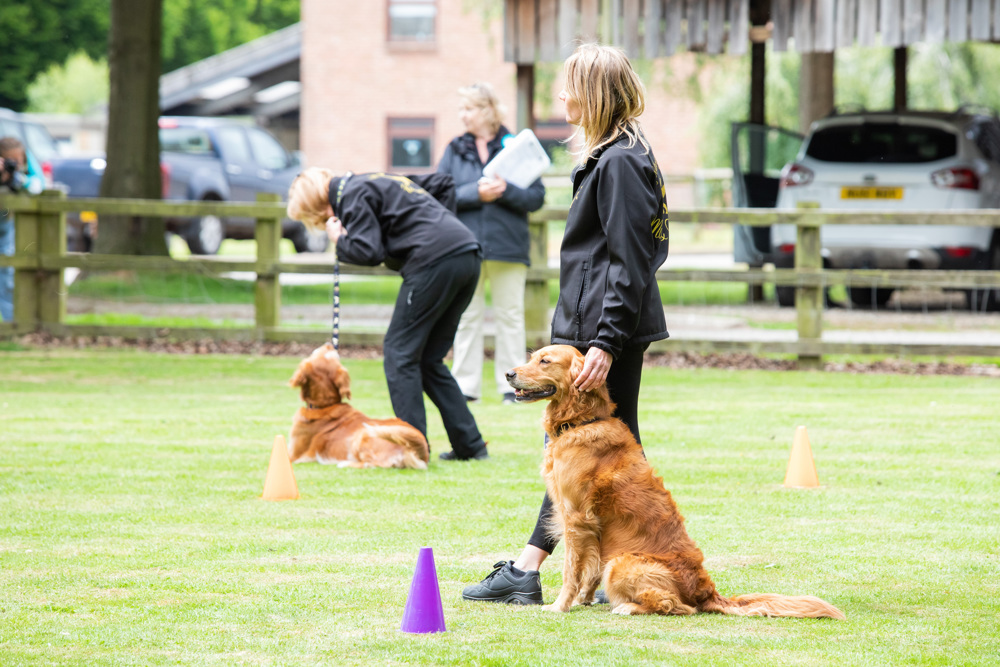
Mitigation and management to support canine health and welfare
Prepared by Dr Jacqueline Boyd
Background
At all times handlers are entirely responsible for a dog under their control at a Kennel Club licensed event.
The health and welfare implications of a dog with a nervous, worried, or otherwise reticent temperament attending and being involved in a canine event should be considered. It will not be in the best interests of the dog or other dogs (and people) to attend or compete at such events.
Incidents where dogs have negative interactions either with other people or dogs are occasionally reported at Kennel Club licensed events.
Such events sometimes indicate that handlers have used equipment identifying dogs as being anxious, worried, nervous, or needing space.
While there is potential value in handlers highlighting specific needs of their dogs in other contexts, it is not recommended that a dog should compete or enter licensed events if carrying such identification and indicating a predisposition and temperament that may be under excessive stress in a high energy, canine competitive environment (and where the awareness and attention of other dogs, handlers and other parties might not always be focused sufficiently to acknowledge or respond to such dog).
The health and safety ramifications with respect to dogs potentially being of a temperament ill-suited to the environs of a competitive event and the use of equipment identifying that a dog requires space or other accommodations should not absolve their handler of responsibility for their dog’s welfare and behaviour.
In addition, handlers and competitors are reminded of the declaration signed on the entry form for competition, as well as The Kennel Club Code of Conduct and the regulation stating that ‘A dog shall be prevented from competition and/or removal from the show if it is: of such temperament or is so much out of control as to be a danger to the safety of any person or other animal’.
Competition organisers and stewards are required to ensure that competition environs are at all times address the safety and health and welfare of all dogs and personnel, in line with existing regulations. This will vary depending on the discipline, a presiding principle must be to minimise the potential for dog-on-dog contact, for example on ensuring adequate physical space for exiting a ring after competing, or during warm-up/queuing.
Use of harnesses, lead slips or coats identifying specific needs
- The use of harnesses, lead slips or coats identifying that a dog requires specific adjustments because of anxiety, fear or temperament at Kennel Club licensed events is not recommended and will not provide mitigation for potential breaches of regulations.
- Handlers are reminded that they are solely responsible for their dog at all times and the use of equipment highlighting specific requirements for their dog does not absolve them of the responsibility to consider the wider health and safety of all participants, human and canine at events.
- The use of identifying equipment does not transfer the responsibility to others (dogs and handlers) to identify and react accordingly to such identifying equipment at Kennel Club licensed events.
Is your dog of suitable temperament to attend a Kennel Club licensed event?
It is important that you assess your own and your dog’s capability to attend and cope with the environs of an event. This includes your dog’s ability to be in proximity to other dogs and people, including in the event where you as a handler may become incapacitated and your dog needs to be managed by other people.
In considering your dog’s suitability, you should reflect on the answers to questions such as:
- Is your dog likely to chase another moving dog or person?
- Do you need people (including judges, stewards, other competitors and event visitors) to behave in a certain way around your dog?
- Do you need additional space provision for your dog, and do you require changes or modifications to the competition or event organisation to ensure this?
- Do you need to use equipment to signal to other people that your dog needs specific adjustments/behaviours around them?
- Is your dog likely to be concerned or negatively react to being held/managed by someone else, for example if you were to be injured?
- Does your dog have an active and current bite history?
- Does your dog suffer from a health condition or is receiving medication that may impact on their ability to cope with an event environment?
- Is your dog’s health, welfare, and wellbeing likely to be compromised by attending an event?
- Is there a material risk that your dog will impact on the health, welfare and wellbeing of other dogs and people at an event?
(This is not an exhaustive list but are factors which would be indicative that your dog would not be suited to competing or attending a licensed event. If you are in any doubt your dog should not be competing/attending.)
